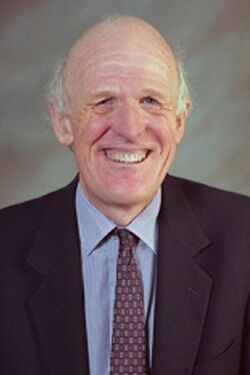Biography:Nicholas C. Handy
Nicholas Handy | |
|---|---|
 | |
| Born | Nicholas Charles Handy 17 June 1941 |
| Died | 2 October 2012 (aged 71) |
| Awards | |
| Scientific career | |
| Fields | Quantum Chemistry |
| Institutions | |
| Doctoral advisor | Samuel Francis Boys[3] |
| Doctoral students |
|
| Website | iaqms |
Nicholas Charles Handy FRS[1] (17 June 1941 – 2 October 2012) was a British theoretical chemist.[4][5] He retired as Professor of quantum chemistry at the University of Cambridge in September 2004.[6]
Education and early life
Handy was born in Wiltshire, England and educated at Clayesmore School.[7] He studied the Mathematical Tripos at the University of Cambridge[3] and completed his PhD on theoretical chemistry supervised by Samuel Francis Boys.[3][8]
Research
Handy wrote 320 scientific papers published in physical and theoretical chemistry journals.[1][6][9] Handy developed several methods in quantum chemistry and theoretical spectroscopy. His contributions have helped greatly to the understanding of:
- the transcorrelated method [10]
- the long range behaviour of Hartree–Fock orbitals
- semiclassical methods for vibrational energies
- the variational method for rovibrational wave-functions (in normal mode and internal coordinates)
- Full configuration interaction with Slater determinants (benchmark studies)
- convergence of the Møller–Plesset series
- the reaction path Hamiltonian
- Anharmonic spectroscopic and thermodynamic properties using higher derivative methods
- Brueckner-doubles theory[citation needed]
- Open shell Møller–Plesset theory
- frequency-dependent properties
- Density functional theory : quadrature, new functionals and molecular properties.
Awards and honours
Handy was elected a Fellow of the Royal Society (FRS) in 1990.[1] He was awarded the Leverhulme Medal in 2002[2] and was a member of the International Academy of Quantum Molecular Science.[11]
Death
On 2 October 2012 Nicholas died after a brief battle with pancreatic cancer.[7]
References
- ↑ 1.0 1.1 1.2 1.3 Clary, David C.; Knowles, Peter J.; Tozer, David J. (2015). "Nicholas Charles Handy 17 June 1941 – 2 October 2012". Biographical Memoirs of Fellows of the Royal Society 61: 145–160. doi:10.1098/rsbm.2015.0002. ISSN 0080-4606.
- ↑ 2.0 2.1 "Leverhulme Medal". Royal Society. Archived from the original on 21 March 2015. https://web.archive.org/web/20150321035351/https://royalsociety.org/awards/leverhulme-medal/. Retrieved 23 November 2012.
- ↑ 3.0 3.1 3.2 3.3 "Death of Professor Nicholas C. Handy, FRS". University of Cambridge. 8 October 2012. Archived from the original on 8 April 2013. https://web.archive.org/web/20130408023705/http://www.ch.cam.ac.uk/news/death-professor-nicholas-c-handy-frs.
- ↑ Yanai, Takeshi; Tew, David P; Handy, Nicholas C (2004). "A new hybrid exchange–correlation functional using the Coulomb-attenuating method (CAM-B3LYP)". Chemical Physics Letters 393 (1–3): 51–57. doi:10.1016/j.cplett.2004.06.011. ISSN 0009-2614. Bibcode: 2004CPL...393...51Y. https://zenodo.org/record/1258873.
- ↑ "Handy - Deaths Announcements - Telegraph Announcements". The Daily Telegraph. http://announcements.telegraph.co.uk/deaths/154843/handy. Retrieved 7 October 2012.
- ↑ 6.0 6.1 "Professor Nicholas Handy". University of Cambridge. Archived from the original on 28 February 2010. https://web.archive.org/web/20100228014301/http://www.ch.cam.ac.uk/staff/nch.html.
- ↑ 7.0 7.1 Buckingham, David. "Nicholas Handy 1941–2012". http://www.iaqms.org/obituary/NicholasHandyObituary.pdf.
- ↑ Coulson, C. A. (1973). "Samuel Francis Boys 1911-1972". Biographical Memoirs of Fellows of the Royal Society 19: 94–115. doi:10.1098/rsbm.1973.0004.
- ↑ Nicholas C. Handy's publications indexed by the Scopus bibliographic database. (Subscription content?)
- ↑ Handy, Nicholas C. (1969). "Energies and Expectation Values for Be by the Transcorrelated Method". The Journal of Chemical Physics 51 (8): 3205–3212. doi:10.1063/1.1672496. Bibcode: 1969JChPh..51.3205H.
- ↑ "Nicholas Handy at the International Academy of Quantum Molecular Science page". Archived from the original on 12 August 2014. https://web.archive.org/web/20140812205923/http://www.iaqms.org/deceased/handy.php.
 |

